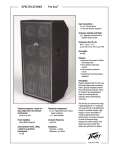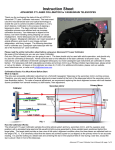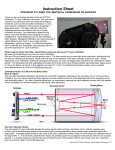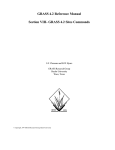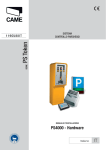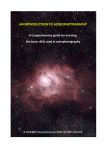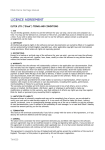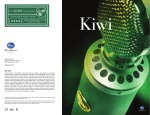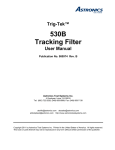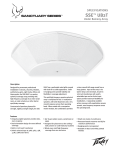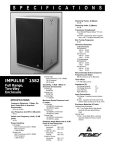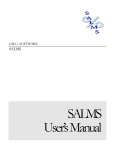Download ALMA Optical Pointing Telescope System
Transcript
TECHNICAL SPECIFICATIONS ASTRONOMICAL TELESCOPE Central Washington University Contents 1.0 INTRODUCTION ................................................................................................................... 3 1.1 Scope of Work....................................................................................................................... 3 2.0 TELESCOPE SPECIFICATIONS .......................................................................................... 3 2.1 Optical Tube Assembly (OTA) ............................................................................................. 3 2.1.1 Optics ............................................................................................................................. 3 2.1.2 Secondary Housing ........................................................................................................ 4 2.1.3 Primary Mirror Cell ....................................................................................................... 5 2.1.4 Optical Tube Assembly (General) ................................................................................. 6 2.2 Telescope Mount ................................................................................................................... 6 2.2.1 Mount Style .................................................................................................................... 6 2.2.2 Drive System .................................................................................................................. 7 2.2.3 Telescope Drive Performance ........................................................................................ 7 2.2.4 Telescope Pointing Model ............................................................................................. 8 2.2.5 Balance System .............................................................................................................. 8 2.2.6 Additional Mount Features ............................................................................................ 8 3.0 INSTRUMENT SPECIFICATIONS ....................................................................................... 9 3.1 Off-Axis Guider Module with Filter Wheel .......................................................................... 9 3.1.1 Basic Design .................................................................................................................. 9 3.1.2 Filter Wheel ................................................................................................................... 9 3.1.3 Filters ........................................................................................................................... 10 3.1.4 Guide Camera .............................................................................................................. 10 3.1.5 Eyepieces ..................................................................................................................... 10 3.1.6 Public Viewing............................................................................................................. 10 3.2 Main Science CCD Camera ................................................................................................ 11 3.3 Auxiliary Refractor ............................................................................................................. 11 4.0 DOME CONTROL AND ENVIRONMENTAL SENSORS ................................................ 11 4.1 Dome Control ...................................................................................................................... 11 4.1.1 Basic Design ................................................................................................................ 11 4.1.2 Dome Control Additional Features .............................................................................. 12 4.2 Environmental sensors ........................................................................................................ 12 4.2.1 Weather Station ............................................................................................................ 12 4.2.2 Cloud Sensor ................................................................................................................ 13 4.2.3 Light Sensor ................................................................................................................. 13 5.0 OBSERVATORY CONTROL SYSTEM ............................................................................. 13 5.1 Control System .................................................................................................................... 13 5.1.1 Capability ..................................................................................................................... 13 1 5.1.2 Safety features .............................................................................................................. 14 5.1.3 Time keeping ............................................................................................................... 14 5.1.4 Control System Cables ................................................................................................. 14 5.2 Control Software Graphical User Interface (GUI) .............................................................. 15 5.2.1 Basic Display ............................................................................................................... 15 5.2.2 Basic Motion ................................................................................................................ 16 5.2.3 Focus Motion ............................................................................................................... 16 5.2.4 Filter Wheel(s) ............................................................................................................. 16 5.2.5 Autoguider stage .......................................................................................................... 16 5.2.6 Autoguider ................................................................................................................... 17 5.2.7 Science CCD Camera .................................................................................................. 17 5.2.8 Dome Interface............................................................................................................. 17 5.3 Scripting Interface ............................................................................................................... 18 6.0 INSTALLATION, SYSTEM INTEGRATION AND TRAINING....................................... 18 6.1.1 Installation.................................................................................................................... 18 6.1.2 Acceptance Testing ...................................................................................................... 18 6.1.3 Staff Training ............................................................................................................... 19 6.1.4 Documentation ............................................................................................................. 19 7.0 VENDOR QUALIFICATIONS, WARRANTIES, SPARE PARTS & MAINTENANCE .. 19 7.1.1 Warranties .................................................................................................................... 19 7.1.2 Spare Parts ................................................................................................................... 19 7.1.3 Maintenance ................................................................................................................. 19 7.1.4 Vendor Qualifications .................................................................................................. 19 2 1.0 INTRODUCTION 1.1 SCOPE OF WORK Central Washington University is requesting solicitations for a new telescope and instrumentation package to be housed in an existing 20ft 6in Ash observatory dome located on the 5th floor of a newly constructed Science Building (Science Phase II) located in the center of the CWU Ellensburg campus. The telescope clear aperture is expected to be in the range of 0.5m to 0.8m. In addition to the telescope, the successful vendor must also supply instrumentation and control of the dome as specified herein. The vendor is also strongly encouraged to provide additional necessary and important equipment for addressing the planned uses of the telescope, to fit within the available budget, as the vendor deems appropriate, as an integral part of the bid. The expected budget for this work will be approximately $325,000 to 350,000. The following construction documents are available for reference purposes: G-002, A-101, A-116, A-801, A-802, EP-108, EP-109, T-001, T-107, T-118, T-119, T-126, and T-214. 2.0 TELESCOPE SPECIFICATIONS 2.1 OPTICAL TUBE ASSEMBLY (OTA) 2.1.1 Optics The optical system shall be a wide-field Ritchey-Chretien design. The largest clear aperture to suit the available budget and fit in the dome is desired but is expected to be in the 0.5-m to 0.8-m range. The effective focal ratio will be matched with the detector to produce the optimum image for the site conditions. The very best seeing conditions are approximately 1.5 arc seconds with typical seeing conditions of 3 to 4 arc seconds. The detector shall be a CCD with 13.5 micron pixels. The unvignetted field of view (FOV) shall accommodate a 2048 x 2048 x 13.5 micron detector. A flat field corrector (doublet or triplet) shall be provided to allow diffraction limited image quality across the entire detector. All optical surfaces of the corrector shall have anti-reflection coatings. The RMS system wave-front error shall be better than λ/15 at λ=633nm. The Peak to Valley system wave-front error shall be ≤ 0.25λ at λ=633nm. The Strehl Ratio shall be >0.8. 3 2.1.2 The central obscuration (effective size of the secondary housing) shall ideally not exceed 33% of the diameter of the primary mirror. Vendor shall address this size in their submission. The mirrors shall have a minimum cosmetic finish (scratch-dig) of 80-50 for the primary and 60-40 for the secondary. The optical substrates for the primary and secondary mirrors shall be of zero expansion ceramics and the vendor must state the material to be used for each mirror. The optical coatings shall cover the wavelength range 350nm to 1000nm. A protective overcoat must be provided. Upon coating, witness samples must be provided by the coating facility. The vendor must provide expected reflectance curves as part of the bid. Primary and secondary light baffles must be provided to fully shield the unvignetted FOV. The baffles must have low reflectivity, typically <2%. In order to develop future instrumentation a full optical description must be provided. This shall include all key parameters including the conic constants. The vendor shall provide polychromatic spot diagrams showing expected performance as part of the bid. The vendor shall provide an analysis of RMS spot size as a function of off-axis distance to show the expected system performance. The vendor shall provide actual optical shop interferometric data and other support documents to show that the optics meet the above specifications. A suitable set of shipping crate(s) must be provided to transport the mirrors during future re-coating of the optics. Secondary Housing The telescope shall be focused by moving the secondary mirror. The focus ram must be equipped with limit switches. Full collimation capability (tip-tilt and centering) must be provided Movement of the focus ram (at least +/- 5mm from the optimum position) must not result in a translation of the image by more than 0.3 arc seconds. The secondary focus travel shall produce a focal plane position change of at least +/20 mm from the nominal focal plane position The focus position repeatability shall be better than 5 microns including initialization errors. The focus readout shall have sufficient resolution. The vendor must show (by optical analysis) that the resolution is adequate, and state the resolution. The focus ram must be equipped with either an absolute encoder or and incremental encoder. The focus mechanism must have passive or active thermal compensation. The vendor must state if this is by carbon fiber or invar, by thermal monitoring or a combination 4 of techniques. If by thermal monitoring an automatic software routine must be provided. The focus shift with slowly changing temperature of 15 degrees C must cause an image enlargement of less than 0.2 arcseconds. This may be demonstrated by analysis. The focus mechanism must have a minimum of two speeds. The maximum time between the two limits shall be no more than 50 seconds. 2.1.3 There must be four spider vanes, equally spaced. Deviation from this standard must be justified by vendor. The focus mechanism must be rigid and stable at all attitudes of the telescope. No sudden changes in the image plane are permitted as the telescope crosses the meridian, or at any other point. The telescope focus motor must be powered ONLY when moving to minimize heat generation. The secondary mirror and its cell shall be removable from the focus assembly without disassembly of the focus housing assembly. Primary Mirror Cell The primary mirror cell must support the mirror at all attitudes of the telescope so as to meet the optical performance specifications. The vendor must state the method used to support the primary mirror. Provision shall be made to hold the primary mirror in the event that the telescope is tipped below the horizon. The primary mirror cell must be removable for mirror servicing without disassembly of the rest of the OTA. The primary cell must be capable of being lowered vertically for servicing. The OTA shall provide access to clean the mirror in place. The primary mirror cell shall be equipped with remote-controllable filter-equipped exhaust fans. The rear of the primary mirror cell shall have an instrument mounting flange. This flange must by machined flat (within 0.025mm, 0.001 inch) and be perpendicular to the optical axis within 1 arc minute so that there is no gradient across the plane of the detector(s). The primary mirror cell must have instrument bolt patterns per the Kitt Peak Van Breda standards or other standard with sufficient vendor justification. The vendor may also provide additional bolt patterns. The vendor must provide an interface control document showing the bolt mounting pattern(s) and the mechanical distance (with no optical elements in the way) from the flange to the focal plane. The vendor may also offer an optional instrument rotator. If available please state the additional price for this feature. A means for conveniently using 2-inch eyepieces with the telescope exploiting its full optical capability must be provided in order to address the teaching and outreach functions the telescope will serve. The preferred approach is a flip mirror of sufficiently robust design to maintain the optical specifications of the telescope with instrumentation, so that the telescope can be quickly switched between eyepiece viewing and instrumentation, but other approaches adequately justified by the vendor will be considered. Also see the off-axis guider section of this document. 5 2.1.4 The primary cell must provide for the mounting of the field corrector. Optical Tube Assembly (General) The preferred optical tube assembly is an open truss design. A closed tube design will be considered if the vendor provides sufficient justification and adequately addresses the performance drawbacks inherent in closed tube designs. The vendor shall state the material to be used for the truss tubes. The OTA shall be capable of carrying an instrument payload of 75 kg or more at a distance of 300 mm from the instrument mounting flange. The OTA shall be capable of carrying auxiliary telescopes or other equipment with a combined weight of at least 50 kg attached to the north and south faces of the center section. The center section of the OTA shall have bolt patterns on the north and south faces for attaching auxiliary equipment, with a minimum of two bolt patterns per side. The bolt pattern is to be specified by the vendor, but a square or rectangular pattern is preferred. A dimensioned drawing specifying the bolt patterns must be supplied with the telescope. The center section or primary mirror cell shall have ports for 115 VAC power outlets, 12 V DC at 1 amp or more, adjustable low voltage DC, network interface, USB and video. All cables and services to the top end of the OTA shall be routed through the truss tubes or otherwise hidden and protected. The vendor shall state how this is to be achieved. Remote controllable covers shall be provided for the primary and secondary mirrors. They must open and close in less than 60 seconds. They must be lightweight so as to not significantly change the balance of the telescope. Tools and a handling cart shall be provided for the safe removal of insertion of the primary mirror. 2.2 TELESCOPE MOUNT 2.2.1 Mount Style The mount shall be an equatorial double fork arm designed for the site latitude. The fork shall be of sufficient length so as to allow access to the north pole. Therefore a cylindrical volume of at least 400mm length and 400mm diameter extending along the optical axis behind the focal plane must be able to pass through the forks. A dimensioned instrument clearance drawing must be provided with the proposal showing in 3 views the instrument clearance volume. The telescope mounting must allow a Field Of Regard (FOR) from the zenith down to a zenith distance of >80 degrees. The proposal must specify the southern zenith distance. The fork arm shall be constructed as either a casting or a weldment. Construction by plates using fasteners is not acceptable. The fork arms must have provision for routing 6 all necessary cables so as to maintain a neat and tidy appearance. The vendor shall clearly state how this is to be achieved. 2.2.2 A pier bolt fixture and sole plate must be supplied with the telescope. Drive System Strong preference will be given to a friction mount drive system. Other methods (onaxis direct drive or worm and worm wheel) will be considered with sufficient vendor justification. If a worm and worm wheel arrangement is used the maximum periodic error before correction shall not exceed 7 arc seconds. The vendor must also provide a full automated periodic error corrector and demonstrate that the maximum residual error is less than 1 arc second. The drive system must allow for discrete steps on the sky of 1/25 arc second or smaller. The drive system must include an encoder feedback system. The vendor must state the type of system used; whether it is on-axis or at another location, and whether it is incremental or absolute. The resolution for each axis shall also be stated. If the encoder system must be initialized the reference fiducial must have a repeatability of 2 arc seconds or less. If the motors are not connected directly to the first friction roller the vendor must state the amount of backlash for each axis (in arc seconds) as a result of the additional gearing system. The vendor shall state if the telescope must be initialized after a power loss and/or at the start of each observing session. A single digitally controlled motor must be used on each axis to achieve tracking and slewing velocities: o Velocity resolution of 0.001 arcseconds per second or finer over the whole velocity range o The system must be capable of sidereal and non-sidereal tracking. The range of non-sidereal tracking capabilities must be detailed in the proposal. o Maximum slew speed of at least 2.5 degrees per second. 2.2.3 The drive system must have a method of release for balance purposes. Replacement drive motors must be easily obtainable and be easily installed in the event of a system failure Telescope Drive Performance The stellar tracking error without optical feedback (from an autoguider) must meet the following specifications: o Error ≤ ±1.2 arc seconds in 300 seconds, as measured crossing the meridian and at the equator o Error ≤ ±5.0 arc seconds in 3600 seconds, as measured crossing the meridian and at the equator To demonstrate the open loop tracking conditions have been met the following verification tests must be performed: 7 o Take a series of 10 seconds exposures throughout the test period and plot a graph of the (XY) centroids. When using optical feedback from an autoguider the performance will be: o Error ≤ ±0.5 arc seconds in 300 seconds, as measured crossing the meridian and at the equator To demonstrate the closed loop tracking conditions have been met the following verification tests must be performed: o Take a series of 10 seconds exposures throughout the test period and plot a graph of the (XY) centroids. o Take a 300 second exposure and examine the image quality 2.2.4 2.2.5 Telescope Pointing Model The mount must have a pointing model correction to allow for flexure. The vendor must clearly state the method used (e.g. TPoint) The telescope must point to better than 30 arc seconds RMS at all positions down to an elevation of 25 degrees. Counterweight/Balance System 2.2.6 The mount must have full capability for rebalancing both the fork and the OTA. The counterweight/balance system must accommodate instrument loads up to 75kg. The vendor will clearly specify how the counterweight system is implemented. Additional Mount Features The mount shall be designed and fabricated for a fixed latitude of 47°00’. The mount shall be fabricated in steel for minimum thermal distortion. Aluminum may be used for non-critical parts to minimize weight. Vendor shall clearly identify composition of mount components in the proposal. The mount must incorporate appropriate polar alignment capability fully described by the vendor in the proposal. The vendor must provide, in the bid, drawings for the telescope interface. Strong preference will be given to a friction mount drive system. Other methods (onaxis direct drive or worm and worm wheel) will be considered provided there is sufficient vendor justification. Sealed polar axle bearings and declination bearings must be used. The vendor shall state the size of the polar axle and the declination axle and the size of the bore through each. The mount shall be painted or powder coated to provide a professional appearance. All fasteners shall be stainless steel 8 All wiring must run in conduits or raceways and provide a neat and orderly system. Provision must be made for guest cables (cameras, instruments, etc.). A minimum provision of 20 square cm in cross-section for guest cables must be available. The vendor shall clearly state how this is to be achieved. For a friction drive telescope a method of locking the drives during instrument changes and mirror removal shall be incorporated into the design. A physical hand paddle shall be provided for engineering purposes. As a minimum it should have three speeds for NSEW and Focus. It shall have the capability to move the dome in azimuth. 3.0 INSTRUMENT SPECIFICATIONS The successful vendor will also provide the basic instrumentation package as outlined in this section. 3.1 OFF-AXIS GUIDER MODULE WITH FILTER WHEEL 3.1.1 3.1.2 Basic Design The off-axis guider with filter wheel shall be a single module attached directly to the bolt pattern of the telescope instrument flange. The instrument shall be fabricated from aluminum and have integral light-lock seals. Stainless steel fasteners shall be used throughout. The interface to the camera must use stainless steel thread inserts. The off-axis guider must use a “2-inch” eyepiece port. The off axis guider camera must be easily removable. The off axis guider must be mounted on a stage to permit motion in the east-west direction. Additional orthogonal motion is highly desirable but not required. The stage should be capable of moving to intercept the primary optical axis so that light normally falling to the main science detector can instead reach an eyepiece. Alternative optical arrangements will be considered and the vendor must provide supporting schematics as part of the bid. Filter Wheel The filter wheel must be capable of holding filters up to 50.8mm (2-inch) square. A total of 14 filter positions are required. A pair of stacked filter wheels may be used in which case each wheel shall contain 8 slots. The filters must be able to be changed with the instrument on the telescope and without removing the camera. The vendor will provide details of how this will be achieved. 9 3.1.3 The filter wheel positions must be repeatable to 10 microns or better. The filter wheel must have an absolute encoder so that the positions of the filters are known at all times. Provision to rotate the filter wheel by hand from the outside of the instrument is highly desirable. The correct position of the wheel must be reported by the software when moving by hand. The motor to the filter wheel must be powered off when not moving under computer control. Filters The vendor shall furnish the following filters: o Bessell U B V R I and Clear as a parfocal set. 50mm square. o Neutral density ND2 (1% transmission). 50mm square. o RED GREEN BLUE LUMINANCE, for color imaging. 50mm square. The filters shall be edge finished and marked with identifying labels. The filters shall be polished and anti-reflection coated. The filters shall be of optical quality commensurate with the optical quality of the telescope. 3.1.4 Guide Camera 3.1.5 The vendor must furnish the guide camera. A suitable camera is the Quantum Scientific Imaging 683s 8.3mp cooled CCD camera with a mechanical shutter. Equivalent cameras from other vendors and clearly identified in the proposal are acceptable. Eyepieces 3.1.6 The ability to use eyepieces during public open night and other functions is also a key feature of the observatory. All eyepieces will be of the “2-inch” barrel size. The vendor must furnish a selection of three or four eyepieces. As part of the bid process the vendor shall provide a table showing the focal length of the eyepieces to be furnished, the apparent field of view, the eyepiece true field of view, the exit pupil size and the magnification. A suitable storage case to hold all of the eyepieces shall be provided. Public Viewing A method of being able to use the eyepieces and then rapidly show the same object using the main science camera must be provided. A hand paddle containing only focus capability or a fixed pair of push buttons must be provided to allow the guest to change the focus of the eyepiece without moving the coordinates of the telescope. 10 3.2 MAIN SCIENCE CCD CAMERA The main science CCD shall also be furnished by the vendor. The detector shall be a 2048 x 2048 x 13.5 micron thinned back-illuminated CCD with Grade 1 cosmetics. The system shall be capable of reaching at least 45C below ambient temperature. A multi-stage peltier cooler is preferred with optional liquid cooling. The cooler shall also be provided. The camera must be provided with a shutter to give a minimum exposure time of 1/10th second or faster. For safety, the camera must be mounted using a bolt pattern rather than an eyepiece draw-tube method. The camera must remain perfectly orthogonal to the optical axis at all orientations of the telescope and must be mounted with no obvious flexure. All cooling hoses and cables shall be routed through the fork arms and polar axle for maximum protection, safety and neat appearance. A method of disconnecting the hoses at the fork arm shall be contrived. 3.3 AUXILIARY FINDER TELESCOPE An auxiliary finder telescope mounted to the main OTA shall be provided. The design may be a doublet or a triplet (preferred) refractor with at least 100 mm aperture but other designs will be considered with appropriate vendor justification. A remote controlled dust cover for the auxiliary finder telescope shall be provided. 4.0 DOME CONTROL AND ENVIRONMENTAL SENSORS The successful vendor shall also provide the basic instrumentation package as outlined in this section. 4.1 DOME CONTROL 4.1.1 Basic Design The dome controller shall allow for the operation of an ASH REBH style dome. The controller shall allow the operation of both doors and also allow the dropout door to remain closed during windy conditions. The azimuth motion shall have a programmable ramp up-down speed. 11 4.1.2 The maximum time to rotate the dome through 360 degrees shall be less than 1 minute. The dome controller shall be able to slowly track the telescope by making very small moves so as not to impart vibration into the system. The dome controller shall be capable of pointing to 0.1 degrees or better. Dome controller shall allow for local and remote operation without resorting to a “Local-Remote” switch that could be left in the wrong position. Dome Control Additional Features The status of the dome doors shall be reported to a local operator in the dome and in the control software. The status for each door shall include Open, Closed, Opening, Closing. The azimuth shall be encoded to at least 0.05 degrees resolution. The azimuth shall have a home sensor or other means of automatically establishing its position, such as an absolute encoder. The dome shall be able to automatically close with signals from at least two independent sensors without relying on software running for those sensors. The dome controller shall be fault-tolerant and close if it loses contact with the host computer The dome controller shall be ASCOM Platform 6 compliant. The dome shall be fully operable even if the telescope control system is turned off. The dome shall be equipped with an emergency stop system that also stops the telescope. 4.2 ENVIRONMENTAL SENSORS 4.2.1 Weather Station A weather station shall be provided. The minimum features are: o Wind speed and direction o Inside and outside temperature o Inside and outside humidity o Barometric pressure o Rain gage The weather station shall interact with the dome controller. Fully integrated software with the main observatory controller is preferred. 12 4.2.2 4.2.3 Cloud Sensor A cloud sensor shall be provided. The cloud sensor shall interact with the dome controller and close the dome even if the main observatory controller is turned off or the software is not operating. Light Sensor A light sensor shall be provided to close the dome at sunrise. The ability for the operator to over-ride this condition shall be provided. 5.0 OBSERVATORY CONTROL SYSTEM 5.1 CONTROL SYSTEM 5.1.1 Capability With the exception of balance, anything that can be done by a human in the dome must also be possible by a remote operator. The ability to conduct operations without ever going into the dome is of prime importance. Full control of the system shall be available both in the observatory and from the remote location in the observatory warm room located on the fourth floor (one floor below the observatory) of the new science building. The control system and telescope shall meet specifications over a minimum temperature range of -5 degrees C to 30 degrees C. The control system shall be located within 15 meters of the telescope pedestal. The control system shall be housed in a NEMA12 or equivalent waterproof and dust proof cabinet. The control system shall ideally be network-based without the need for control cards being placed in a computer chassis. The control system shall be able to operate from a modern 64-bit computer using the latest version of the operating system. A laptop computer running an up to date operating system with a minimum screen size of 17-inch shall be provided with the controller. The control system must have both a graphical user interface and a scripting interface. The proposal must include screen captures of the software interface and a full description of how the system can be used to conduct remote real-time observations over the internet. The proposal must state the capabilities, if any, for autonomous observations where no observer is present. 13 5.1.2 5.1.3 Safety features The control system shall be equipped with an emergency stop system. Emergency stop buttons are to be provided at the dome controller, on the telescope and in the warm room / control cabinet area. They shall be of the twist lock style. An equivalent “EMERGENCY STOP” button must be included in the software and be visible at all times. The emergency stop buttons must stop all motion including, but not limited to, the telescope, the dome and the instrument. The emergency stop button must cancel any pending motion. The telescope and dome position shall not be lost as a result of pressing the emergency stop button. Upon releasing the button the system should be ready for use as if the button had not been activated and accept new commands without initializing. A safety interlock shall be provided to automatically detect people in the dome. When persons are in the dome the software should stop high-speed slewing from remote locations and report people in the dome. Tracking and slow motions must not be interrupted. Time keeping The control system must report the time to 10ms or better. The vendor shall state how the time service is derived (GPS, WWV, internet, etc.). A GPS clock may be incorporated. However, the system must still be able to function in the event the GPS signal is not locked or the GPS clock is broken. The time service must be broadcast to all the computers used in the local area network for the operation of the observatory so that they are all synchronized. Vendor is to coordinate this with CWU’s Project Manager. 5.1.4 Control system cables: Multiple conductor cables will be used. Whenever possible, the cables shall have connectors on each end so they may be disconnected at the computer or Motor Driver Chassis end and at a disconnect panel near the device they support (for example, drive motor, encoder, limit switch assembly, etc.) Cables must have a suitable temperature rating for the expected observatory environment. Cables should be shielded and properly grounded whenever necessary to prevent EMI. Multiple pin connectors should be 1 turn to lock wherever possible. Connectors must use gold plated pins and sockets wherever possible. Cables of like function (for example R.A. and Declination servo motor cables) should be the same wherever possible. Cables must be labeled on both ends. Cables should be run wherever possible within the telescope structure or within conduits. 14 Wrap up of the cables must be protected. The proposal must state how this will be done. 5.2 CONTROL SOFTWARE GRAPHICAL USER INTERFACE (GUI) A single unified graphical user interface is required to allow control of the telescope, instrument, guide camera, science camera, dome and auxiliary sensors. 5.2.1 Basic Display The following basic parameters must be displayed in the GUI: o Julian date o Civil Date and time o Universal Time and date (UTC) o Sidereal Time o Telescope position (R.A., Declination, Hour Angle) o Zenith distance, altitude and azimuth o Tracking rates in R.A. and Declination o Focus position for all ports o Telescope limits and any warnings regarding approaching limits o Telescope mirror cover(s) status o Dome doors (main and dropout) status o Dome azimuth o Dome status (manual, auto, moving etc.) o Filter wheel status o Guider status (on, off, corrections) o CCD Shutter status (opened, closed). The following methods are required for object entry: o Keyboard input for Object Name, RA, Declination, Epoch, proper motions o From a file with the contents of the file available in a scrollable database o The ability to edit and save custom databases o The ability to sort the database by name, R.A., Declination, proper motions, magnitude, etc. A GoTo, STOP and Cancel button are required for telescope slewing. The GUI shall display “Target out of Range” if the object is not accessible to the telescope. 15 5.2.2 Basic Motion The GUI shall automatically apply any proper motions, precession, refraction, flexure, etc. to point the telescope at the desired object The telescope must be able to accept moves in: o Right Ascension and Declination (tracking at destination) o Hour Angle and Declination (static at destination) o Offsets in Right Ascension and Declination (to fractions of an arc second) o Moves (NSEW) from a software GUI hand paddle o Moves (NSEW) from a physical hand paddle (when in the dome) 5.2.3 If the telescope requires initialization there must be a means of doing this in the interface. Focus Motion The GUI shall have a focus interface with at least the following features: o Focus position for the main telescope (secondary mirror) o Focus position for the autoguider o The ability to move to an absolute focus value o The ability to offset the focus by a specified amount o Display the limit status of the focus ram 5.2.4 The vendor should state if an automatic focus routine is (or is not) available, and if not, scripting capabilities must be sufficient to incorporate an automatic focus routine into the telescope operation by the end user. Filter Wheel(s) The GUI shall have a filter wheel interface with the following capabilities: o Display the names of the filter(s) currently in the beam o Display the names of all the filters available including “empty” positions o Allow the astronomer to change the names of the filters 5.2.5 The vendor should state if there is (or is not) provision for automatically changing the focus for different filter thicknesses and how this is accomplished. Autoguider stage The GUI shall have a guider stage interface with the following capabilities: o Report position of the stage o Report if the stage is blocking the main science camera o Allow the user to move the stage to guider field and eyepiece viewing (centered) o If the vendor is proposing a different optical layout then the corresponding GUI must be clearly explained. 16 5.2.6 Autoguider The GUI shall have an autoguider guider interface with the following capabilities: o Report status of the autoguider (On/Off) o Ability to start and stop guiding o Report corrections being applied (graphical plot and/or numerical values) 5.2.7 CCD Camera The GUI shall have a detector interface with the following capabilities: o Report the status of the shutter (Open, Closed) o Allow for Light Bias Dark and Flat exposure types o Allow for binning and sub-arrays o Set exposure time and number of exposures o Allow for file management including auto-saving images The images shall be saved it FITS format and the headers must have (beside the statutory parameters) the following minimum entries: o Location o Date / time (U.T., exposure start) o Julian Date o Exposure time (seconds) o Object Name o Object R.A., Declination o Airmass o Object Type (Light, Bias , Dark, Flat) o Filter name(s) o Telescope Focus o Observer Name(s) o Instrument name o CCD Temperature o Dome azimuth o Autoguider status (on-off) 5.2.8 Dome Interface The GUI shall have a dome interface with the following capabilities: o Report status of both doors o Report dome azimuth o Report status (manual, automatic, moving, etc.) 17 o Allow for the dome motion to be stopped without affecting the telescope motion o Allow for the dome to be sent to a home or park position 5.3 SCRIPTING INTERFACE The control system shall have the ability to script observations. The system can use ASCOM Platform 6 or a similar scheme The vendor shall provide a detailed description of the proposed scripting capabilities. As a minimum, the scripting interface must be capable of obtaining sequences of images with the following quantities specified for each image and/or each group of images in the sequence: o Filter o Image exposure time o Camera binning o Focus position o Astronomical coordinates of object and associated dome position o Image file name o Time delays between images o Calibration frames (darks, flats, bias) o Subframe readout 6.0 6.0 INSTALLATION, SYSTEM INTEGRATION AND TRAINING The vendor is required to provide a “turnkey” working system so that the system is ready for use. In addition, basic training shall be provided. 6.1.1 6.1.2 Installation The vendor is responsible for the shipping and installation of the telescope and all of the equipment. The cost of crane rental and any other equipment required for the installation is the responsibility of the vendor. The telescope must be precisely polar aligned using the drift technique using the CCD camera. Acceptance Testing The vendor will provide, as part of the bid process, a detailed set of acceptance test procedures to demonstrate that the technical specifications have been met. The acceptance tests are to be completed and acceptable prior to staff training. 18 6.1.3 Staff Training In addition to acceptance tests the vendor will provide up to two additional evenings of staff training, which may be by remote login so as to take advantage of favorable weather conditions. 6.1.4 Documentation A Technical Reference Manual (intended for maintenance staff) detailing the basic optical, mechanical and electronic features of the telescope must be supplied. A recommended maintenance program shall be included. A User Manual (intended for astronomers) detailing how to use the equipment must be supplied. All of the OEM documentation for the auxiliary equipment such as the CCD cameras, weather station, eyepieces, etc. shall be provided. 7.0 7.0 VENDOR QUALIFICATIONS, WARRANTIES, SPARE PARTS & MAINTENANCE 7.1.1 Warranties The warranty period shall commence at the date of final acceptance. The warranty period for the telescope, telescope controller and dome controller shall be as follows: o Telescope Mount & OTA 3 years o Telescope & Dome Controller 2 years o Optical Coatings 1 year o Laptop computer 1 year The warranty period for the following auxiliary equipment shall be 1 year or the OEM warranty, whichever is the longer: o CCD camera o Autoguider Camera o Weather station o Cloud sensor 7.1.2 Spare Parts The vendor shall supply a list of vital spare parts together with a price list for these components. 7.1.3 Maintenance The University is interested in any after-service programs that the vendor may have to offer, such as extended annual maintenance. If these are available, the vendor should indicate the options in the proposal. 19 7.1.4 Vendor Qualifications The proposal must include a list of similar telescopes that the vendor has supplied with contact name, institute name, telephone number, and e-mail address. Provide a list of the vendor’s key personnel and a brief statement of their experience. Provide a list of the contractor’s facilities. End of Document 20




















